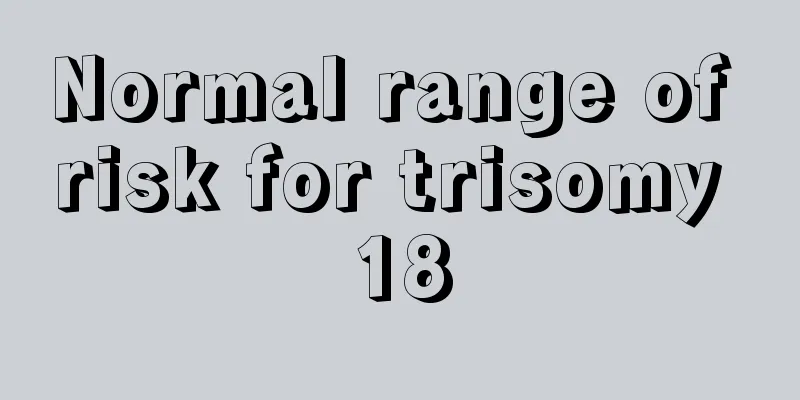Normal range of risk for trisomy 18

|
Everyone knows that pregnant mothers need to undergo Down syndrome screening. This is a necessary examination to prevent children with Down syndrome. It is also an assessment to ensure the current health status of the baby in the belly. During the Down syndrome screening process, some blood will be drawn from the pregnant mother and then tested. At the same time, there are many precautions to be aware of during the examination. Similarly, the normal value range of trisomy risk is also a concern for many mothers. Cause Analysis Down syndrome screening involves drawing blood from the pregnant mother and calculating the risk of having a child with Down syndrome based on alpha-fetoprotein, the mother's weight, blood sugar, age, etc. It is usually done between 14 and 20 weeks. Precautions 1. Do prenatal check-ups on time to reduce the probability of fetal malformations; 2. Pay attention to folic acid supplementation to avoid fetal malformation; 3. Do appropriate exercise, eat a balanced diet, and pay attention to rest during pregnancy. Secondly, after understanding the relevant knowledge about high-risk Down syndrome screening, pregnant mothers with high-risk Down syndrome screening can choose to do a non-invasive fetal free DNA test. The non-invasive fetal free DNA test involves drawing blood from the pregnant woman's vein, extracting and examining the baby's cells in the blood using a special instrument, and analyzing the chromosome structure and number of the chromosomes in the extracted baby's cells. To determine whether there is trisomy 21, trisomy 18 or trisomy 13, and whether there are structural and numerical abnormalities in other chromosomes. If the non-invasive test shows low risk, then most babies are normal. Just have regular prenatal checkups. The accuracy of this screening is over 90%. If non-invasive testing indicates a high risk, prenatal diagnosis is needed. Finally, prenatal diagnosis mainly includes chorionic villus sampling, amniocentesis, and umbilical cord blood puncture. These tests generally have the highest accuracy rates. If the Down syndrome screening or non-invasive test shows high risk, prenatal diagnosis is recommended to clarify the condition. |
<<: Does the cervix open faster when giving birth to the third child?
>>: What medicine is good for women who have frequent nocturia?
Recommend
Ibuprofen for children during breastfeeding
Key reminder: Children's ibuprofen puree and ...
Fat people should take vitamin C supplements! Because fat will "steal" nutrients little by little
What troubles does obesity bring? Eating more tha...
Don't let the cold wave "freeze" your health! Please check the protection guide
First snow embraces cold wave The first snow usua...
What does breast hyperplasia mean?
Diseases continue to harm people's health as ...
What to do if the egg cannot be released
The egg is a kind of reproductive cell discharged...
What season is suitable for eating American ginseng? Is American ginseng good or bad?
Many people like to drink American ginseng in wat...
How many days does it take for the embryo to implant?
The place where the human egg and male sperm fuse...
What is the reason for bloody vaginal discharge during non-menstrual period?
Over the past few years. Gynecological diseases a...
Suspensory ligament of ovary
When it comes to the uterus and ovaries, I believ...
A woman has blue veins on her forehead
The blue veins on a woman's forehead may be c...
How long does it take for menopausal insomnia to heal?
The life of female menopausal insomnia patients i...
Can fermented rice wine eggs really enlarge breasts?
As a common fermented rice food derivative, ferme...
What are the functions and benefits of green olives? How to make delicious green olive dishes
Olive salad is a local dish in Chaoshan, Guangdon...
[Health Lecture] "Bronchioloma of the lungs" - don't be too nervous
We received such a patient in the pathology depar...









